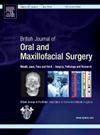Comparing the socio-economic and emotional implications of management of a hypoplastic cleft maxilla with distraction osteogenesis or orthognathic surgery in a developing country
IF 1.9
4区 医学
Q3 DENTISTRY, ORAL SURGERY & MEDICINE
British Journal of Oral & Maxillofacial Surgery
Pub Date : 2025-05-01
DOI:10.1016/j.bjoms.2025.02.006
引用次数: 0
Abstract
Management of a hypoplastic maxilla can be addressed through distraction osteogenesis (DO) or orthognathic surgery (OS), with DO being preferred for severe deformity due to the increased stability of its long-term outcomes. This study aims to compare the economic and emotional implications of DO versus OS at an Indian institute. A total of 20 patients who underwent maxillary DO were compared with 20 patients who underwent orthognathic Le Fort I osteotomy. Sourced from the GSR Institute of Craniofacial Surgery database, patients completed a telephone questionnaire, via a translator, which investigated: return travel costs to hospital, length of hospital stay, Likert scales gauging mood and impact on daily life before, during, and after treatment. There was a marked increased mean length of hospital stay associated with rigid external device (RED) in comparison with OS by 70.5%. This is also associated with a greater mean total cost of hospital stay per patient, also by 70.5%. The mean number of visits to hospital postoperatively was over twice the number of visits for RED in comparison with OS, associated with a staggering 859.9% increase in financial burden on RED patients compared with OS with regards to mean total return travel costs to hospital. There was a 36.8% percentage change in impact on daily life scores for RED patients compared with 25.0% percentage change associated with OS. While DO appears advantageous, its economic drawbacks emphasise the necessity for a comprehensive evaluation of clinical and economic outcomes in low-resource settings. Limitations included challenges due to various regional languages and absence of pre-existing maxillary deficiency data.
比较发展中国家上颌发育不全与牵张成骨或正颌手术治疗的社会经济和情感影响。
上颌发育不全的治疗可以通过牵张成骨术(DO)或正颌手术(OS)来解决,由于DO的长期结果增加了稳定性,因此对严重畸形的治疗更受欢迎。本研究旨在比较DO与OS在印度研究所的经济和情感影响。将20例上颌DO患者与20例正颌Le Fort I截骨患者进行比较。来自GSR颅面外科研究所的数据库,患者通过翻译完成了一份电话问卷,调查内容包括:往返医院的费用,住院时间,李克特量表测量情绪以及治疗前,治疗期间和治疗后对日常生活的影响。与OS相比,与刚性外部装置(RED)相关的平均住院时间显着增加70.5%。这也与每位患者的平均住院总费用增加有关,也增加了70.5%。与OS相比,RED患者术后的平均住院次数是RED患者的两倍多,与平均总往返医院费用相比,RED患者的经济负担增加了惊人的859.9%。RED患者对日常生活评分的影响变化百分比为36.8%,而与OS相关的变化百分比为25.0%。虽然DO似乎是有利的,但其经济上的缺点强调了在低资源环境下对临床和经济结果进行综合评估的必要性。局限性包括各种区域语言的挑战和缺乏预先存在的上颌缺陷数据。
本文章由计算机程序翻译,如有差异,请以英文原文为准。
求助全文
约1分钟内获得全文
求助全文
来源期刊
CiteScore
3.60
自引率
16.70%
发文量
256
审稿时长
6 months
期刊介绍:
Journal of the British Association of Oral and Maxillofacial Surgeons:
• Leading articles on all aspects of surgery in the oro-facial and head and neck region
• One of the largest circulations of any international journal in this field
• Dedicated to enhancing surgical expertise.

 求助内容:
求助内容: 应助结果提醒方式:
应助结果提醒方式:


